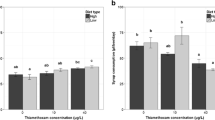Abstract
This study describes the impact of sublethal doses of 4 pesticides on size and morphology of the honeybee worker’s hypopharyngeal glands. This gland plays an essential role in brood care by young workers, and thus colony growth. Contaminating 7 day old caged bees, we sampled after 1 day and 1 week for Captan-, Imidacloprid- and Indoxacarb-treated bees and after 1, 2, 3, 4, 5 and 7 days for Fenoxycarb-treated bees. The glands’ acini 1 week post-treatment were all significantly smaller in treated bees. However, lightand electron microscopy showed hardly any difference between controls and gland cells, treated with Captan, Imidacloprid or Indoxacarb. Yet upon Fenoxycarb-treatment, acini showed a decrease in size, a granular texture and unorganized cytoplasm more quickly than normal. Indeed, after only 7 days, Fenoxycarb-treated glands displayed features typical of the onset of foraging in older bees.
Similar content being viewed by others
References
Bortolotti L., Montanari R., Marcelino J., Medrzycki P., Maini S., Porrini C. (2003) Effects of sub-lethal imidacloprid doses on the homing rate and foraging activity of honey bees, Bull. Insectology 56, 63–67.
Buckingham S.D., Lapied B., Le Corronc H., Grolleau F., Sattelle D.B. (1997) Imidacloprid actions on insect neuronal acetylcholine receptors, J. Exp. Biol. 200, 2685–2692.
Chauzat M.P., Faucon J.P., Martel A.C., Lachaize J., Cougoule N., Aubert M. (2006). Survey of Pesticide Residues in Pollen Loads Collected by Honey Bees in France, J. Econ. Entomol. 99, 253–262.
Cruz Landim C. da, Hadek R. (1969) Ultrastructure of Apis mellifera hypopharyngeal gland, Proc. 6th Int. Congr. IUSSI, Bern, pp. 121–130.
Decourtye A., Armengaud C., Renou M., Devillers J., Cluzeau S., Gauthier M., Delegue M.H.P. (2004) Imidacloprid impairs memory and brain metabolism in the honeybee (Apis mellifera L.), Pest. Biochem. Physiol. 78, 83–92.
Deseyn J., Billen J. (2005) Age-dependent morphology and ultrastructure of the hypopharyngeal gland of Apis mellifera workers (Hymenoptera, Apidae), Apidologie 36, 49–57.
Dhadialla T.S., Carlson G.R., Le D.P. (1998) New insecticides with ecdysteroidal and juvenile hormone activity, Annu. Rev. Entomol. 43, 545–569.
El Hassani A.K., Dacher M., Gary V., Lambin M., Gauthier M., Armengaud C. (2008) Effects of sublethal doses of acetamiprid and thiamethoxam on the behavior of the honeybee (Apis mellifera), Arch. Environ. Contam. Toxicol. 54, 653–661.
Faucon J.-P., Mathieu L., Ribiere M., Martel A.-C., Drajnudel P., Zeggane S., Aurieres C., Aubert M.F.A. (2002) Honey bee winter mortality in France in 1999 and 2000, Bee World 83, 14–23.
Furquim K.C.S., Camargo-Mathias M.I., Silva de Moraes R.L.M. (2004) Morphological modifications induced by an artificial diet on the hypopharyngeal glands of Apis mellifera (Hymenoptera, Apidae) during their degenerative process, Sociobiology 43, 45–49.
Haynes K.F. (1988) Sublethal effects of neurotoxic insecticides on insect behavior, Annu. Rev. Entomol. 33, 149–168.
Hrassnigg N., Crailsheim K. (1998) Adaptation of hypopharyngeal gland development to the brood status of honeybee (Apis mellifera L.) colonies, J. Insect Physiol. 44, 929–939.
Lapied B., Grolleau F., Sattelle D.B. (2001) Indoxacarb, an oxadiazine insecticide, blocks insect neuronal sodium channels, Br. J. Pharmacol. 132, 587–595.
Malone L.A., Todd J.H., Burgess E.P.J., Christeller J.T. (2004) Development of hypopharyngeal glands in adult honey bees fed with a Bt toxin, a biotin binding protein and a protease inhibitor, Apidologie 35, 655–664.
Medrzycki P., Montanari R., Bortolotti L., Sabatini A.G., Maini S., Porrini V. (2003) Effects of Imidacloprid administered in sub-lethal doses on honey bee behaviour. Lab tests, Bull. Insectology 56, 59–62.
Ohashi K., Natori S., Kubo T. (1997) Change in the mode of gene expression of the hypopharyngeal gland cells with an age-dependent role change of the worker honeybee Apis mellifera L., Eur. J. Biochem. 249, 797–802.
Owens R.G. (1969) Metabolism of fungicides and related compounds, Ann. N.Y. Acad. Sci. 160, 114–132.
Robinson G.E., Ratnieks F.L.W. (1987) Induction of premature honey bee (Hymenoptera: Apidae) flight by juvenile hormone analogs administered orally or topically, J. Econ. Entomol. 80, 784–787.
Rutz W., Gerig L., Wille H., Lüscher M. (1974) A bioassay for juvenile hormone (JH) effects of insect growth regulators (IGR) on adult worker honeybees, Bull. Soc. Entomol. Suisse 47, 307–313.
Sasagawa H., Sasaki M., Okada I. (1989) Hormonal control of the division of labor in adult honeybees (Apis mellifera L.). I. Effect of methoprene on corpora allata and hypopharyngeal gland, and its α-glucosidase activity, Appl. Entomol. Zool. 24, 66–77.
Silva de Moraes R.L.M., Bowen I.D. (2000) Modes of cell death in hypopharyngeal glands of honey bee (Apis mellifera L.), Cell Biol. Int. 24, 737–743.
Simpson J., Riedel I.B.M., Wilding N. (1968) Invertase in the hypopharyngeal glands of the honeybee, J. Apic. Res. 7, 29–36.
Suchail S., Guez D., Belzunces L.P. (2001) Discrepancy between acute and chronic toxicity induced by imidacloprid and its metabolites in Apis mellifera, Environ. Toxicol. Chem. 20, 2482–2486.
Tasei J.N. (2001) Effects of insect growth regulators on honey bees and non-Apis bees. A review, Apidologie 32, 527–545.
Thompson H.M., Wilkins S., Battersby A.H., Waite R.J., Wilkinson D. (2005) The effects of four insect growth-regulating (IGR) insecticides on honeybee (Apis mellifera L.) colony development, queen rearing and drone sperm production, Ecotoxicology 14, 757–769.
Thompson H.M., Wilkins S., Battersby A., Waite R.J., Wilkinson D. (2007) Modelling long-term effects of IGRs on honey bee colonies, Pest Manage. Sci. 63, 1081–1084.
Tsurubuchi Y., Kono Y. (2003) Modulation of sodium channels by the oxadiazine insecticide indoxacarb and its N-decarbomethoxylated metabolite in rat dorsal root ganglion neurons, Pest Manage. Sci. 59, 999–1006.
van der Steen J. (2001) Review of the methods to determine the hazard and toxicity of pesticides to bumblebees, Apidologie 32, 399–406.
Author information
Authors and Affiliations
Corresponding author
Additional information
Manuscript editor: Monique Gauthier
Rights and permissions
About this article
Cite this article
Heylen, K., Gobin, B., Arckens, L. et al. The effects of four crop protection products on the morphology and ultrastructure of the hypopharyngeal gland of the European honeybee, Apis mellifera . Apidologie 42, 103–116 (2011). https://doi.org/10.1051/apido/2010043
Received:
Revised:
Accepted:
Published:
Issue Date:
DOI: https://doi.org/10.1051/apido/2010043




